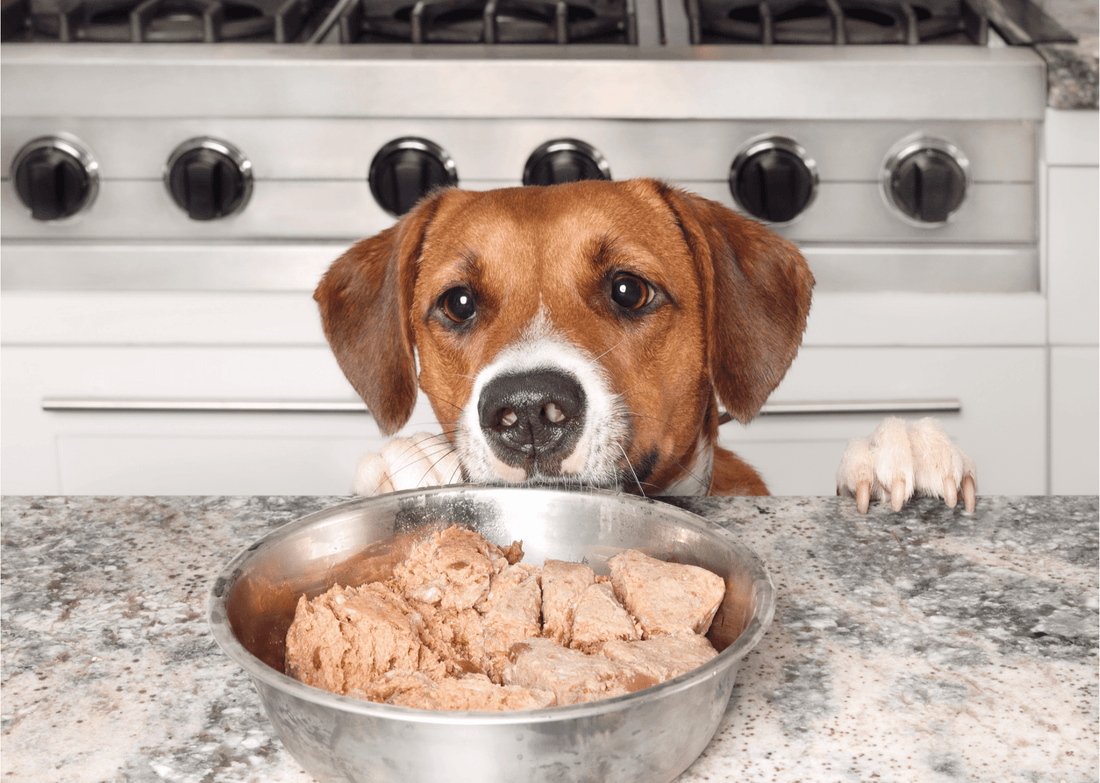Hi there dog lovers! We hope you're enjoying our What's On Your Dog's Plate blog series and have found the previous posts on kibble, raw and dried food valuable?
For our fifth instalment, we are concentrating on canned, wet food. Let's explore the pros and cons to help you decide if it's the right choice for your furry friend.
The Pros of Canned Wet Dog Food: A Moist and Flavourful Feast:
High Moisture Content:
Canned wet dog food boasts a high moisture content, typically around 75-85%. This is great for hydration, especially for dogs who don't drink enough water. It can be particularly beneficial if your dog is senior or has kidney or urinary tract issues.
Palatability:
Wet dog food tends to be more palatable than dry kibble, thanks to it's rich aroma and soft texture. Picky eaters often find canned food more appealing, making mealtimes a more enjoyable experience for both you and your dog.
Easy to Digest:
The soft, moist texture of canned food is easier on the digestive system, making it an excellent option for dogs with dental issues or those recovering from surgery or illness. It can also be gentler on the stomach if your dog has digestive sensitivities.
High-Quality Protein:
Many canned dog foods feature high-quality protein sources as their primary ingredients. Look for wet food with at least 60% meat content, ideally 80%. This ensures your pup is getting a protein-rich meal that supports muscle maintenance, growth and overall health.
Fewer Fillers:
Compared to kibble and some dried options, canned wet food tends to contain fewer fillers, like corn, wheat and soy. This can lead to better nutrient absorption and a lower risk of allergies and intolerances.
The Cons of Canned Wet Dog Food: Considerations to Keep in Mind:
Processing Impact:
To produce wet food, the ingredients are mixed together and cooked. Afterward, they're pressure-sealed into tins and undergo another heating process for sterilisation. This means the food has been through two rounds of high-heat processing, which can affect the nutrient content. Whilst wet food retains a lot of goodness, it's important to keep this in mind when considering it's nutritional value.
Cost:
Canned wet dog food can be more expensive than other options, particularly kibble, especially for larger dogs and multi-pet households. The cost can add up quickly, making it a less economical choice for some dog owners.
Storage:
Once opened, canned food needs to be refrigerated and used within a few days to prevent spoilage. This can be less convenient than dried food or kibble, which have a longer shelf life and are easier to store.
Dental Health:
While wet food is easier to chew, it doesn't provide the same dental benefits as dried food or kibble. The lack of crunch means it doesn't help to clean or reduce plaque and tartar buildup in your dog's mouth. Regular dental care is essential to maintain oral health, and our completely natural chews will be worth considering as an add-on snack for your pup.
Calorie-Density:
Canned wet food can be more calorie-dense than dried, so portion control is crucial to avoid overfeeding and weight gain. It's important to measure servings accurately and adjust based on your dog's activity level and nutritional needs.
Potential for Selective Eating:
Some dogs may become selective eaters when fed canned wet food, developing a preference for the moist texture and rich flavours. This can make it challenging to switch to other types of food if needed.
Finding the Right Fit: Customised Nutrition:
In conclusion, canned wet dog food offers a hydrating, palatable and high-quality feeding option, especially suited to dogs with specific dietary needs or preferences. However, it comes with considerations such as processing impacts, cost, storage, dental health, calorie control and potential selective eating habits. As always, the best choice depends on your dogs' individual needs and your lifestyle.
Stay tuned for our next blog post, where we'll explore the pros and cons of cooked dog food, delving into how it compares to other feeding options (spoiler alert - it would always be our second preference if we were unable to feed Amber raw!).


